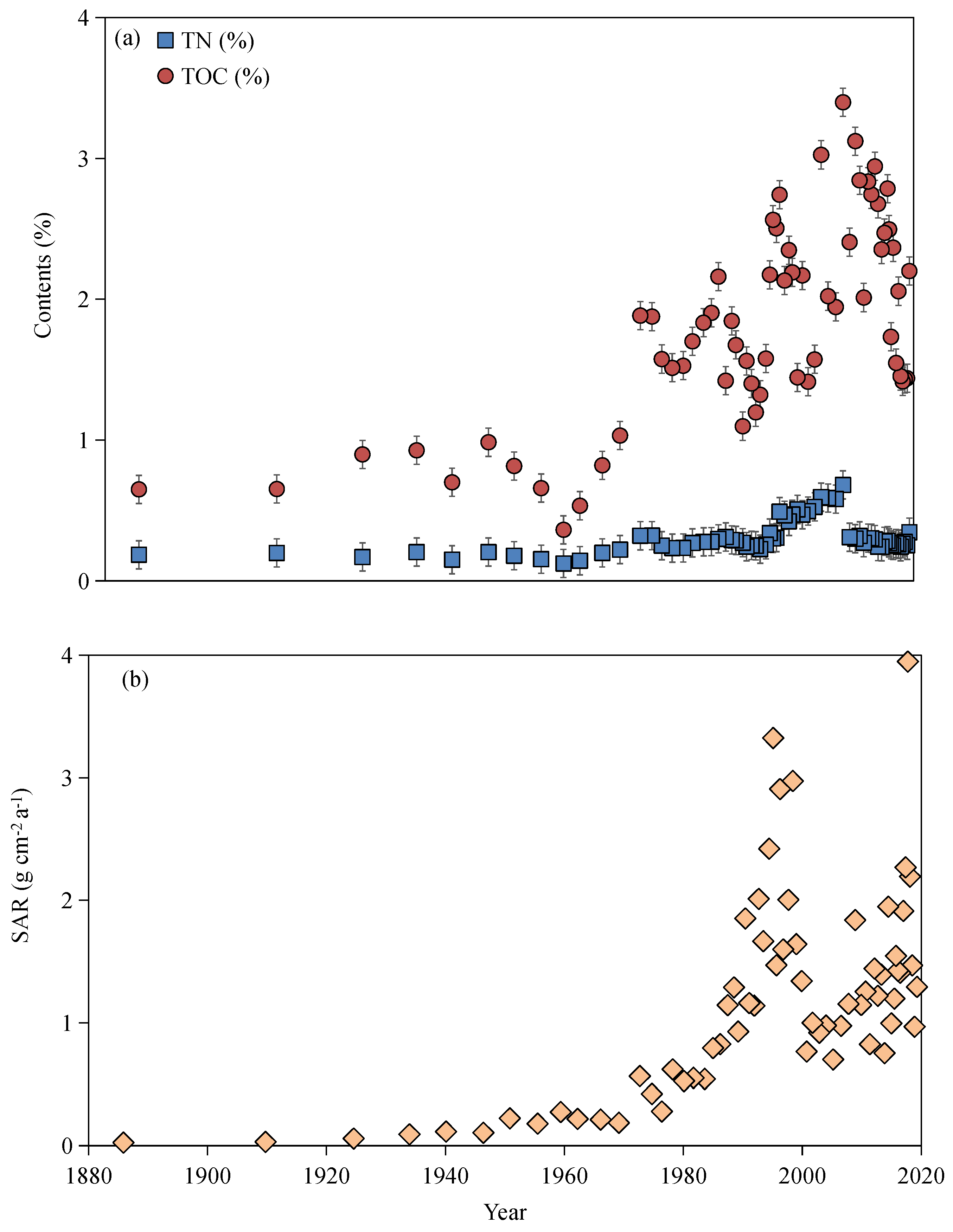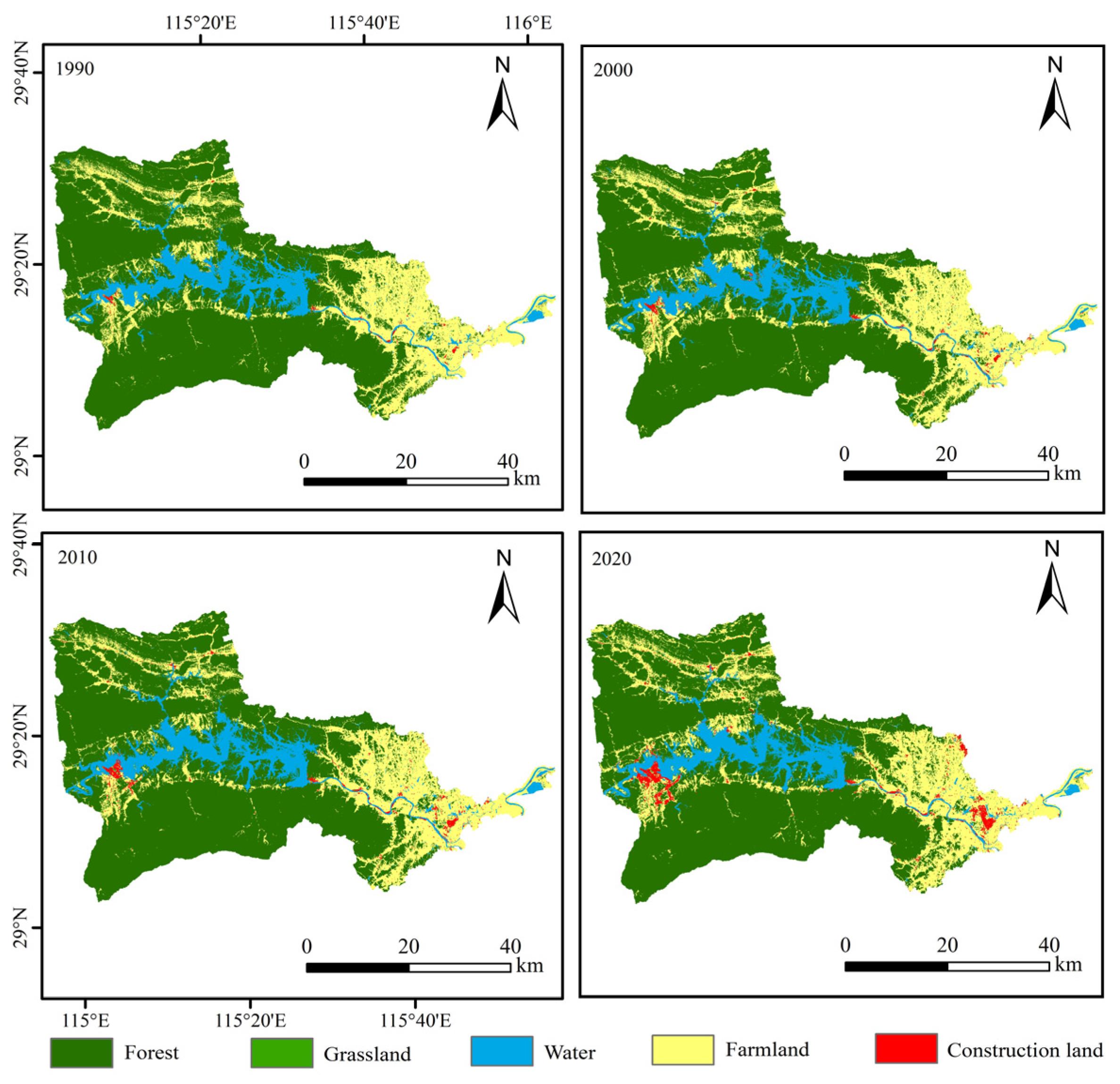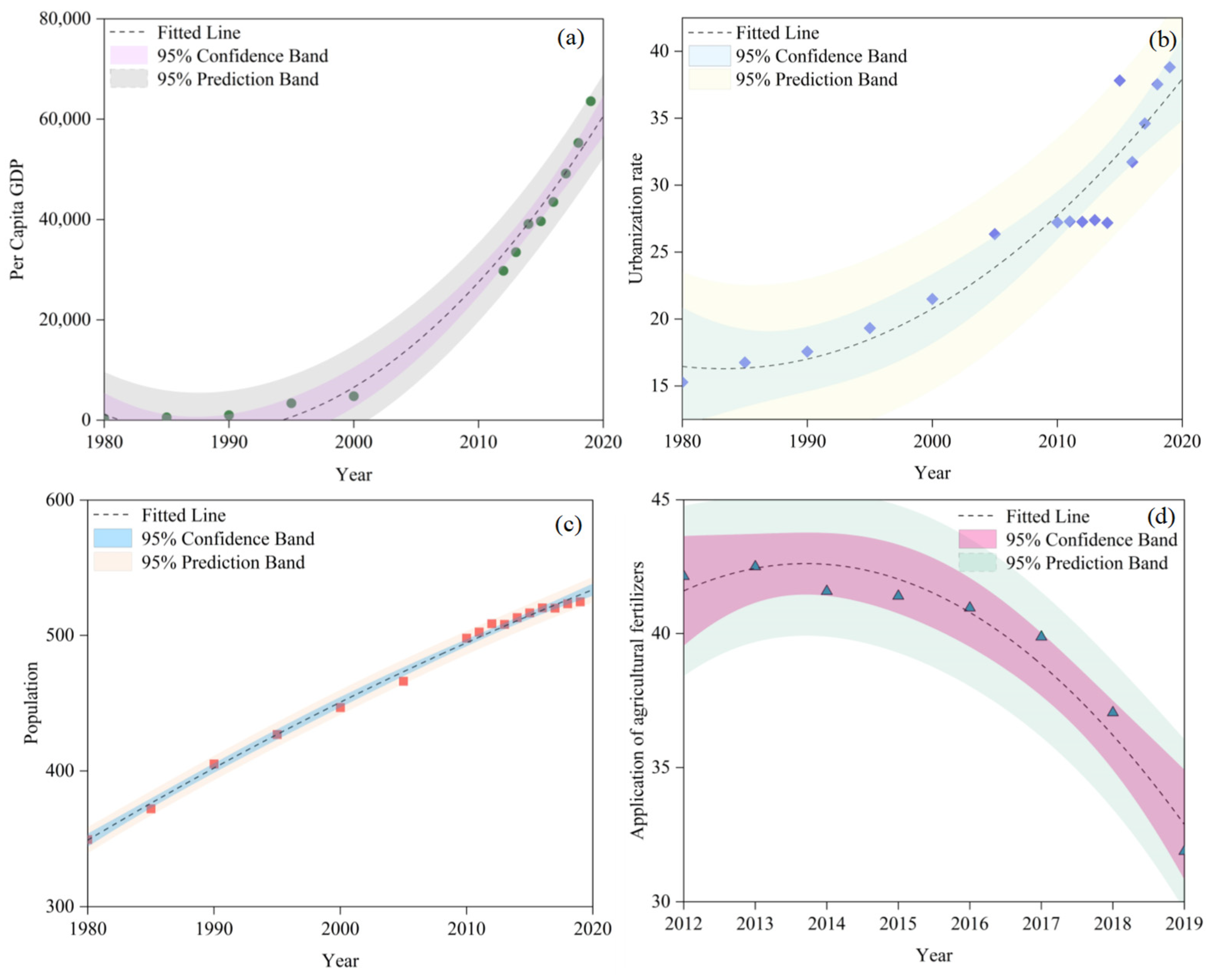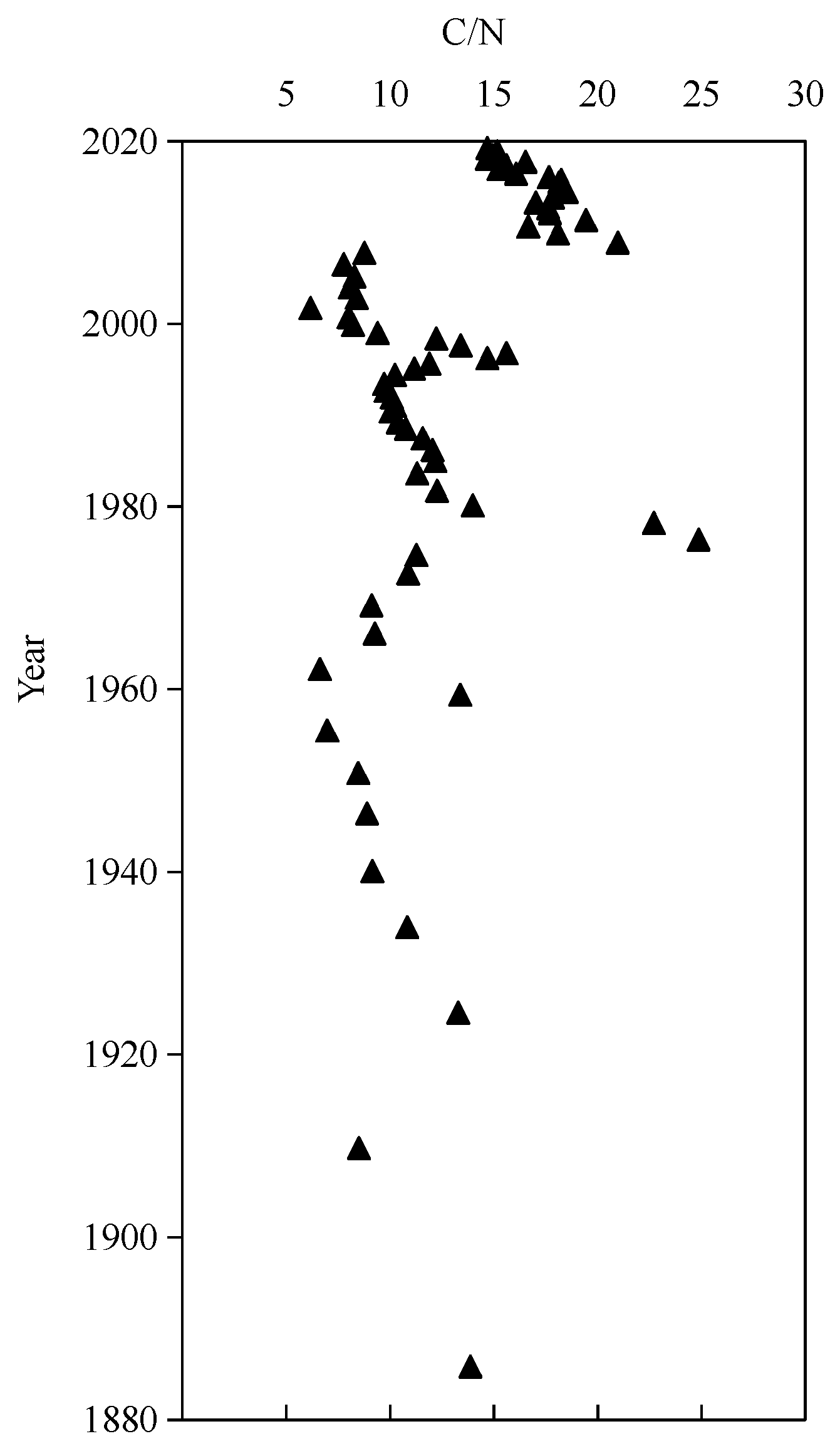Carbon Accumulation Associated with Its Influencing Factors in Sediments from the Poyang Basin
Abstract
1. Introduction
2. Materials and Methods
2.1. Natural Resources in the Study Area
2.2. Cultural Conditions in the Area
2.3. Sample Collection and Pretreatment
2.4. Determination of 210Pb, 226Ra, TN, TOC and OCAR
3. Results and Discussion
3.1. Characteristics of SAR, C, and N Burial
3.2. Mechanism Driving OCAR Change in Sediments
3.3. Influencing Factors and Their Identification
3.3.1. Time Variation in Temperature and Precipitation
3.3.2. Changes in Land Use and Land Cover
3.3.3. Socio and Economic Conditions
3.4. Organic Matter Origin Indicated by the C/N Ratios
4. Conclusions
Author Contributions
Funding
Data Availability Statement
Conflicts of Interest
References
- Venugopalan, V.P.; Kumar, R.; Sekar, R.; Rajamohan, R.; Nair, K.V.K. Natural eutrophication in a shallow freshwater lake: Impact and possible restoration strategy. In Restoration and Management of Tropical Eutrophic Lakes; CRC Press: Boca Raton, FL, USA, 2005. [Google Scholar]
- Huang, C.; Zhang, L.; Li, Y.; Lin, C.; Huang, T. Carbon and nitrogen burial in a plateau lake during eutrophication and phytoplankton blooms. Sci. Total Environ. 2018, 616–617, 296–304. [Google Scholar] [CrossRef] [PubMed]
- Sobek, S.; Zurbrügg, R.; Ostrovsky, I. The burial efficiency of organic carbon in the sediments of Lake Kinneret. Aquat. Sci. 2011, 73, 335–364. [Google Scholar] [CrossRef]
- Cole, J.J.; Prairie, T.Y.; Caraco, F.N.; McDowell, H.W.; Tranvik, J. Plumbing the Global Carbon Cycle: Integrating Inland Waters into the Terrestrial Carbon Budget. Ecosystems 2007, 10, 171–184. [Google Scholar] [CrossRef]
- Lin, J.; Zhou, X.; Lu, X.; Xu, Y.; Wei, Z. Grain size distribution drives microbial communities vertically assemble in nascent lake sediment. Environ. Res. 2023, 227, 115828. [Google Scholar] [CrossRef] [PubMed]
- Wang, Y.; Yang, H.; Zhang, J.; Xu, M.; Wu, C. Biomarker and stable carbon isotopic signatures for 100–200 year sediment record in the Chaihe catchment in southwest China. Sci. Total Environ. 2015, 502, 266–275. [Google Scholar] [CrossRef]
- Hu, C.; Xu, H.; Shi, S.; Lan, J.; Zhou, K. Sedimentary organic matter molecular composition reveals the eutrophication of the past 500 years in Lake Daihai, Inner Mongolia. Environ. Res. 2023, 227, 115753. [Google Scholar] [CrossRef]
- Dean, E.W.; Gorham, E. Magnitude and significance of carbon burial in lakes, reservoirs, and peatlands. Geology 1998, 26, 783–786. [Google Scholar] [CrossRef]
- Ding, Y.; Wang, S.; Zhang, W.; Feng, M.; Yu, R. A rule of hydrological regulating on nutritional status of Poyang Lake, since the operation of the Three Gorges Dam. Ecol. Indic. 2019, 104, 535–542. [Google Scholar] [CrossRef]
- Evgeniya, S.; Evgeniya, S.; Dong, Y.; Vladimir, I.; Li, J. Arsenic in groundwater of the Poyang Lake area (China): Aqueous species and health risk assessment. Environ. Geochem. Health 2022, 45, 2917–2933. [Google Scholar] [CrossRef]
- Xu, X.; Tan, Z.; Li, Y.; Li, Y.; Wang, X. Effects of water-table depth and soil moisture on plant biomass, diversity, and distribution at a seasonally flooded wetland of Poyang Lake, China. Chin. Geogr. Sci. 2015, 25, 739–756. [Google Scholar] [CrossRef]
- Liu, H.; Zhang, Q.; Niu, Y. A Dataset of Water Environment Survey in the Poyang Lake from 2013 to 2018. Available online: http://www.sciencedb.cn/dataSet/handle/876 (accessed on 9 May 2023).
- Chen, Y.; Zhao, Z.; Wang, Y.; Zhu, W.; Wu, H. Effects of organic carbon burial on biomarker component changes in contamination in northeast Dianchi watershed. J. Hazard. Mater. 2023, 445, 130474. [Google Scholar] [CrossRef]
- Tian, J.; He, X.; Wu, H.; Chen, Y.; Yu, K. Driving forces underlying changes in carbon molecular component deposition in a river-lake ecotone. Ecol. Indic. 2023, 147, 109976. [Google Scholar] [CrossRef]
- Wang, Y.; Huang, Y.; Tian, J.; Li, C.; Yu, K. A sediment record of terrestrial organic matter inputs to Dongting Lake and its environmental significance from 1855 to 2019. Ecol. Indic. 2021, 130, 108090. [Google Scholar] [CrossRef]
- Sun, C.; Zhen, L.; Wang, C.; Yan, B.; Cao, X. Impacts of ecological restoration and human activities on habitat of overwintering migratory birds in the wetland of Poyang Lake, Jiangxi Province, China. J. Mt. Sci. 2015, 12, 1302–1314. [Google Scholar] [CrossRef]
- Wu, D.; Shao, Q.; Li, J. Effects of afforestation on carbon storage in Boyang Lake Basin, China. Chin. Geogr. Sci. 2013, 23, 647–654. [Google Scholar] [CrossRef]
- Yang, J.; Huang, X. The 30 m annual land cover dataset and its dynamics in China from 1990 to 2019. Earth Syst. Sci. Data 2021, 13, 3907–3925. [Google Scholar] [CrossRef]
- Zhang, Q.; Ye, H.; Ding, Y.; Cao, Q.; Zhang, Y. Carbon storage dynamics of subtropical forests estimated with multi-period forest inventories at a regional scale: The case of Jiangxi forests. J. For. Res. 2020, 31, 1247–1254. [Google Scholar] [CrossRef]
- Qin, H.; Cao, X.; Cui, L.; LV, Q.; Chen, T. The Influence of Human Interference on Zooplankton and Fungal Diversity in Poyang Lake Watershed in China. Diversity 2020, 12, 296. [Google Scholar] [CrossRef]
- Zhao, G.; Li, Y. Effects of a Proposed Hydraulic Project on the Hydrodynamics in the Poyang Lake Floodplain System, China. Int. J. Environ. Res. Public Heath 2021, 18, 8072. [Google Scholar] [CrossRef]
- Debela, T.M.; Wu, Q.; Chen, L.; Sun, X.; Xu, Z. Composition and Diversity of Over-Wintering Aquatic Bird Community on Poyang Lake, China. Diversity 2020, 12, 308. [Google Scholar] [CrossRef]
- Xu, Y. Jiangxi Statistical Yearbook; China Statistical Publishing House: Beijing, China, 2020; pp. 4–5. [Google Scholar]
- Appleby, P.G.; Oldfieldz, F. The assessment of 210Pb data from sites with varying sediment accumulation rates. Hydrobiologia 1983, 103, 29–35. [Google Scholar] [CrossRef]
- Huang, C.; Chen, Z.; Gao, Y.; Luo, Y.; Huang, T. Enhanced mineralization of sedimentary organic carbon induced by excess carbon from phytoplankton in a eutrophic plateau lake. J. Soil. Sediment. 2019, 19, 2613–2623. [Google Scholar] [CrossRef]
- Gudasz, C.; Sobek, S.; Bastviken, D.; Koehler, B.; Tranvik, L.J. Temperature sensitivity of organic carbon mineralization in contrasting lake sediments. J. Geophys. Res. Biogeosci. 2015, 120, 1215–1225. [Google Scholar] [CrossRef]
- Heathcote, A.J.; Downing, J.A. Impacts of Eutrophication on Carbon Burial in Freshwater Lakes in an Intensively Agricultural Landscape. Ecosystems 2012, 15, 60–70. [Google Scholar] [CrossRef]
- Gudasz, C.; Bastviken, D.; Steger, K.; Premke, K.; Sobek, S. Temperature-controlled organic carbon mineralization in lake sediments. Nature 2010, 466, 478–481. [Google Scholar] [CrossRef]
- Ferland, M.E.; Giorgio, P.A.; Teodoru, C.R.; Prairie, Y.T. Long-term C accumulation and total C stocks in boreal lakes in northern Québec. Glob. Biogeochem. Cycles 2012, 26, 1–10. [Google Scholar] [CrossRef]
- Kortelainen, P.; Pajunen, H.; Rantakari, M.; Saarnisto, M. A large carbon pool and small sink in boreal Holocene lake sediments. Glob. Chang. Biol. 2004, 10, 1648–1653. [Google Scholar] [CrossRef]
- Huang, C.; Yao, L.; Zhang, Y.; Huang, T.; Zhang, M. Spatial and temporal variation in autochthonous and allochthonous contributors to increased organic carbon and nitrogen burial in a plateau lake. Sci. Total Environ. 2017, 390, 603–604. [Google Scholar] [CrossRef] [PubMed]
- Meyers, P.A. Organic geochemical proxies of paleoceanographic, paleolimnologic, and paleoclimatic processes. Org. Geochem. 1997, 27, 213–250. [Google Scholar] [CrossRef]
- Meyers, P.A. Preservation of elemental and isotopic source identification of sedimentary organic matter. Chem. Geol. 1994, 114, 289–302. [Google Scholar] [CrossRef]
- Redfield, A.C.; Ketchum, B.H.; Richards, F.A. The influence of organisms on the composition of sea-water. Sea 1963, 2, 26–77. [Google Scholar]
- LaZerte, B.D. Stable carbon isotope ratios: Implications for the source of sediment carbon and for phytoplankton carbon assimilation in Lake Memphremagog, Quebec. Can. J. Fish. Aquat. Sci. 1983, 40, 1658–1666. [Google Scholar] [CrossRef]
- Hedges, J.I.; Clark, W.A.; Quay, P.D.; Richey, J.E.; Devol, A.H. Compositions and fluxes of particulate organic material in the Amazon River. Limnol. Oceanogr. 1986, 31, 717–738. [Google Scholar] [CrossRef]






| Year | Population/104 People | Urban Population/104 People | Rural Population/104 People | Urbanization Rate | Households | Per Capita GDP/CNY |
|---|---|---|---|---|---|---|
| 1980 | 349.53 | 53.44 | 296.09 | 15.29% | 71.76 | 330 |
| 1985 | 372.20 | 62.35 | 309.85 | 16.75% | 79.69 | 561 |
| 1990 | 405.23 | 71.19 | 334.04 | 17.57% | 94.74 | 989 |
| 1995 | 426.91 | 82.51 | 344.49 | 19.32% | 107.22 | 3372 |
| 2000 | 446.83 | 96.09 | 350.74 | 21.50% | 114.54 | 4771 |
| 2005 | 466.20 | 122.83 | 343.37 | 26.35% | 133.36 | / |
| 2010 | 497.91 | 135.57 | 362.34 | 27.23% | 156.85 | / |
| 2011 | 502.43 | 137.14 | 365.29 | 27.30% | 162.36 | / |
| 2012 | 508.61 | 138.68 | 369.93 | 27.27% | 164.47 | 29,785 |
| 2013 | 508.09 | 139.17 | 368.92 | 27.39% | 165.91 | 33,500 |
| 2014 | 513.13 | 139.50 | 373.63 | 27.19% | 168.01 | 39,097 |
| 2015 | 516.59 | 195.40 | 321.19 | 37.82% | 164.25 | 39,645 |
| 2016 | 520.36 | 165.13 | 355.22 | 31.73% | 162.32 | 43,502 |
| 2017 | 520.14 | 180.03 | 340.11 | 34.61% | 162.84 | 49,157 |
| 2018 | 523.39 | 196.49 | 326.89 | 37.54% | 163.07 | 55,274 |
| 2019 | 524.86 | 203.74 | 321.12 | 38.82% | 164.37 | 63,584 |
| Year | Average Temperature in Wuning County/°C | Average Precipitation in Wuning County/mm |
|---|---|---|
| 2017 | 17.20 | 1751.40 |
| 2016 | 17.90 | 179.60 |
| 2015 | 17.60 | 1865.30 |
| 2014 | 17.60 | 1513.70 |
| 2013 | 18.10 | 1219.70 |
| 2012 | 16.70 | 1012.60 |
| 2011 | 17 | 1012.60 |
| 2010 | 17 | 1871.90 |
| 2009 | 17.30 | 1190.60 |
| Year | Area/km2 | ||||
|---|---|---|---|---|---|
| Farmland | Forest | Grassland | Water Body | Construction Land | |
| 1990 | 570.27 | 1640.58 | 0.19 | 239.74 | 10.37 |
| 2000 | 592.01 | 1607.75 | 0.11 | 242.67 | 18.62 |
| 2010 | 537.53 | 1646.65 | 0.19 | 249.62 | 27.16 |
| 2020 | 594.53 | 1566.67 | 0.07 | 246.23 | 53.65 |
| Parameter | Principal Component (PC) for All Data | |
|---|---|---|
| PC1 | PC2 | |
| OC | 0.96 | −0.23 |
| Temperature | −0.70 | 0.69 |
| Precipitation | 0.13 | −0.99 |
| Urbanization rate | 0.90 | 0.43 |
| Application of agricultural fertilizers | −0.99 | −0.14 |
| Per capita GDP | 0.96 | 0.24 |
| Population | 0.90 | 0.43 |
| Farmland area | 0.35 | −0.92 |
| Forest area | −0.82 | 0.54 |
| Water area | 0.53 | 0.79 |
| Construction land area | 0.10 | 0.05 |
| Charact. root | 7.01 | 3.72 |
| Var. Contribut. Rate (%) | 63.72 | 33.80 |
| Cum. Var. Contribut. Rate (%) | 63.72 | 97.52 |
Disclaimer/Publisher’s Note: The statements, opinions and data contained in all publications are solely those of the individual author(s) and contributor(s) and not of MDPI and/or the editor(s). MDPI and/or the editor(s) disclaim responsibility for any injury to people or property resulting from any ideas, methods, instructions or products referred to in the content. |
© 2023 by the authors. Licensee MDPI, Basel, Switzerland. This article is an open access article distributed under the terms and conditions of the Creative Commons Attribution (CC BY) license (https://creativecommons.org/licenses/by/4.0/).
Share and Cite
Tian, J.; Wu, J.; Wu, H.; Zhang, M.; Zhao, Z.; Wang, Y. Carbon Accumulation Associated with Its Influencing Factors in Sediments from the Poyang Basin. Water 2023, 15, 2199. https://doi.org/10.3390/w15122199
Tian J, Wu J, Wu H, Zhang M, Zhao Z, Wang Y. Carbon Accumulation Associated with Its Influencing Factors in Sediments from the Poyang Basin. Water. 2023; 15(12):2199. https://doi.org/10.3390/w15122199
Chicago/Turabian StyleTian, Jiaming, Jing Wu, Hanzhi Wu, Mingli Zhang, Zihan Zhao, and Yanhua Wang. 2023. "Carbon Accumulation Associated with Its Influencing Factors in Sediments from the Poyang Basin" Water 15, no. 12: 2199. https://doi.org/10.3390/w15122199
APA StyleTian, J., Wu, J., Wu, H., Zhang, M., Zhao, Z., & Wang, Y. (2023). Carbon Accumulation Associated with Its Influencing Factors in Sediments from the Poyang Basin. Water, 15(12), 2199. https://doi.org/10.3390/w15122199






